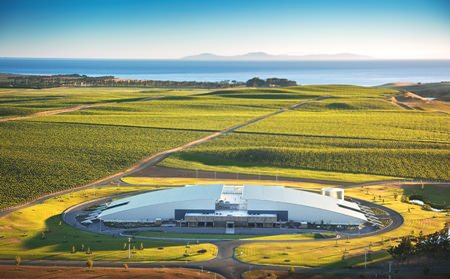If you were to wander around the Yealands Estate vineyards in New Zealand, you might be surprised to hear the strains of classical music coming from loudspeakers. The music is not for the benefit of the vineyard workers you understand, but for the vines. Strange as it may seem, the concept is not completely new. At the vineyards of the De Morgenzon farm in Stellenbosch, they’ve played baroque instrumental music to the vines for several years evidently resulting in healthier leaves and grapes.
Peter Yealands of Yealands Wine Group told me, “Our vines enjoy a varied daily playlist, which includes music from a range of world-class composers, and of course, a few of my personal favourites. It’s played at roughly seventy decibels under the speaker (which is about living-room volume) but it varies through the vineyard because of the rolling contours of the land and the effect of wind direction. We’ve noticed that the leaves on the vines directly under the speakers appear to hold their colour and stay on the vines for longer. We’ve also discovered that the chickens which live in the area where the music is played produce larger eggs. The chickens really seem to appreciate the music.”
 The impressive Yealands winery among the vineyards.
The impressive Yealands winery among the vineyards.
And so do the sheep. You see, there are also sheep roaming among the vines. They’re an old English breed known as Babydolls and they grow only up to about two feet high. They were introduced by Peter Yealands because they’re the perfect answer to keeping the grass under control without the noise and carbon emissions produced by conventional tractors. They aren’t tall enough to reach the grapes, but they’re content with the grass that grows between the vines. It’s been estimated that these sheep save the equivalent of two thousand miles per year of mechanical mowing. At one time they needed seven tractors to do the work. And of course, the little sheep are much prettier than tractors. When they’re not mowing the grass, the sheep apparently congregate underneath the speakers, an area they never used to visit.
Peter Yealands is a man who’s passionate about sustainability and he has a vision to create the world’s most environmentally-friendly wines. Yealands Family Wines has already been selected as the “Green Company of the Year” by the UK’s leading drinks publisher, Drinks Business. It’s the largest privately owned vineyard in New Zealand and home to the country’s biggest solar power installation. Even the loudspeakers run on solar power.
The company has won hundreds of awards and these wines represent amazingly good value. Incidentally, their Marlborough Sauvignon Blanc claimed a Gold Medal and prestigious trophy at the Decanter World Wine Awards held recently in London. The Peter Yealands Sauvignon Blanc 2013 took home the Regional Trophy for the best New Zealand Sauvignon Blanc under £15 (about Bt. 750), with judges naming it as the “benchmark Kiwi Sauvignon Blanc”.
Peter Yealands Hawke’s Bay Chardonnay 2013 (white), New Zealand (Bt. 759 @ Villa)
The 2013 vintage in Hawke’s Bay (on the East Coast of the country’s North Island) provided outstanding conditions for ripening the Chardonnay grapes and produced fruit with a fine balance of ripeness and freshness. Under the supervision of winemaker Tamra Washington the grapes were gently pressed and some of the juice was fermented in French oak barriques to bring a complexity of aroma and texture.
This very pale, straw-coloured wine has a sumptuous honeyed aroma with rich pineapple, apricot, melon and hints of citrus. The wine has a lovely silky mouth-feel, a couple of degrees away from total dryness and a fine touch of acidity that helps to bring the fruit into focus. It has a mouth-filling richness and subtle oak flavours which continue right through to the fresh elegant finish. This is a big, bold wine full of interest and character. It has an alcohol content of 13.5%, and the pleasing dash of acidity would make it a good partner for many chicken dishes or well-flavoured lemony fish. This is a classic New Zealand Chardonnay with a touch of the Old World about it.
Peter Yealands Marlborough Pinot Noir 2013 (red), New Zealand (Bt. 839 @ Villa)
If your geographical knowledge of New Zealand is a bit hazy, perhaps I should remind you that Marlborough is located at the North East tip of the South Island. It was named after the British Duke of Marlborough, a wildly ambitious individual who, in the early years of the 18th century, rose to become the Commander-in-Chief of the British forces. Some historians believe that Marlborough (whose real name was the rather more prosaic John Churchill) was the greatest British commander in history.
This is a splendid wine. For a start, the weather was particularly good and this helped the low-yielding Pinot Noir grapes to produce intense fruit flavours. It’s a lovely bright red with hints of orange and a fascinating aroma which kept me busy for quite some time. Your first few sniffs should tell you that you’re in for something interesting. Initial impressions are of red fruit against a background of dark evergreen forest. There are rich fruity aromas of cherry and plum and as you swirl the wine around, other tantalising background aromas start to come through. You might, if you have a good nose for these things, pick up hints of tree bark and spice.
The feeling on the palate is magical; a soft and silky texture, with the fruit forward and well-focused by the tiniest tang of acidity. The fruit brings the slightest impression of sweetness though the wine itself is completely dry and there’s also a satisfying layer of soft tannin which goes through into the long, dry finish. Wine writers often suggest that Pinot Noir is best paired with pork or lamb, but I am going to enjoy this on its own if you don’t mind, even though it has 14% alcohol content which is pretty much at the top of the tree for table wines. In many ways, it’s a text-book New Zealand Pinot Noir. And do you know? When I put my ear to the glass and listened carefully, I’d swear that I could hear, far in the distance, the faint sounds of classical music.




